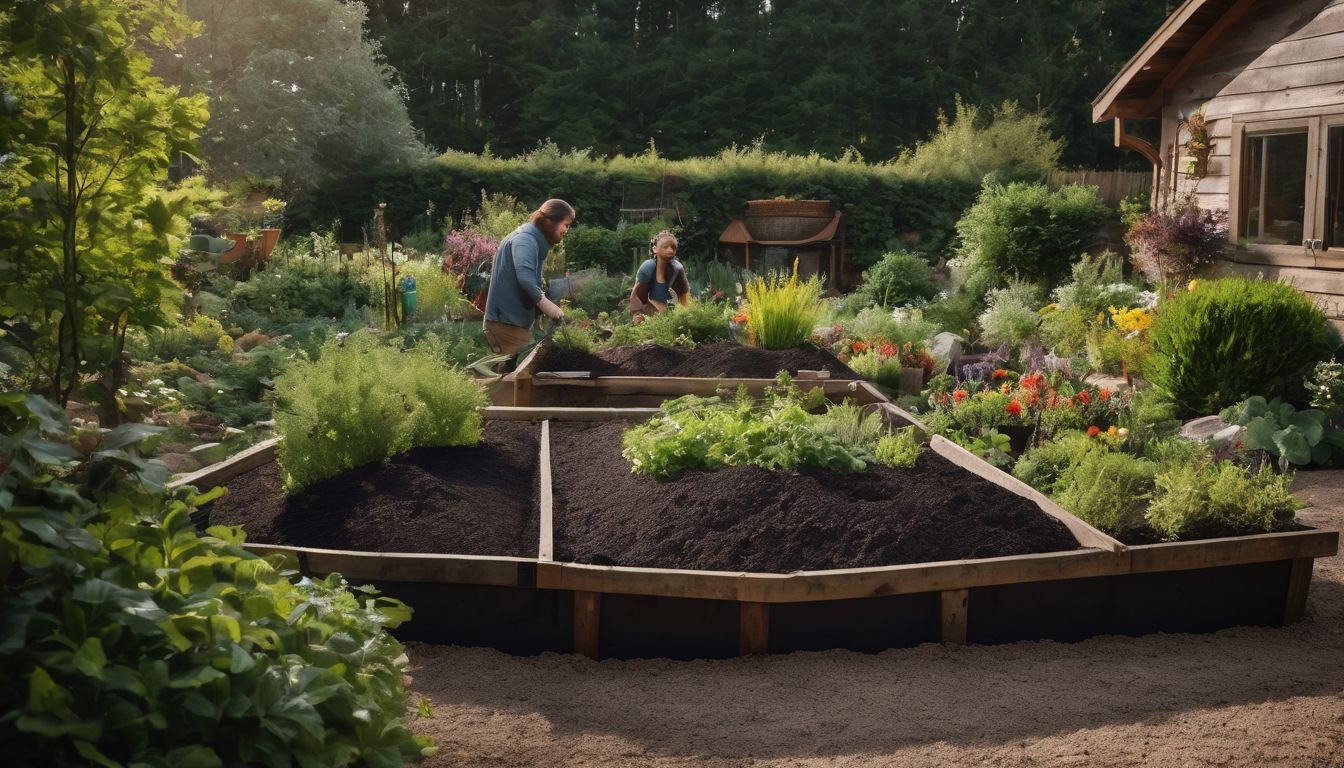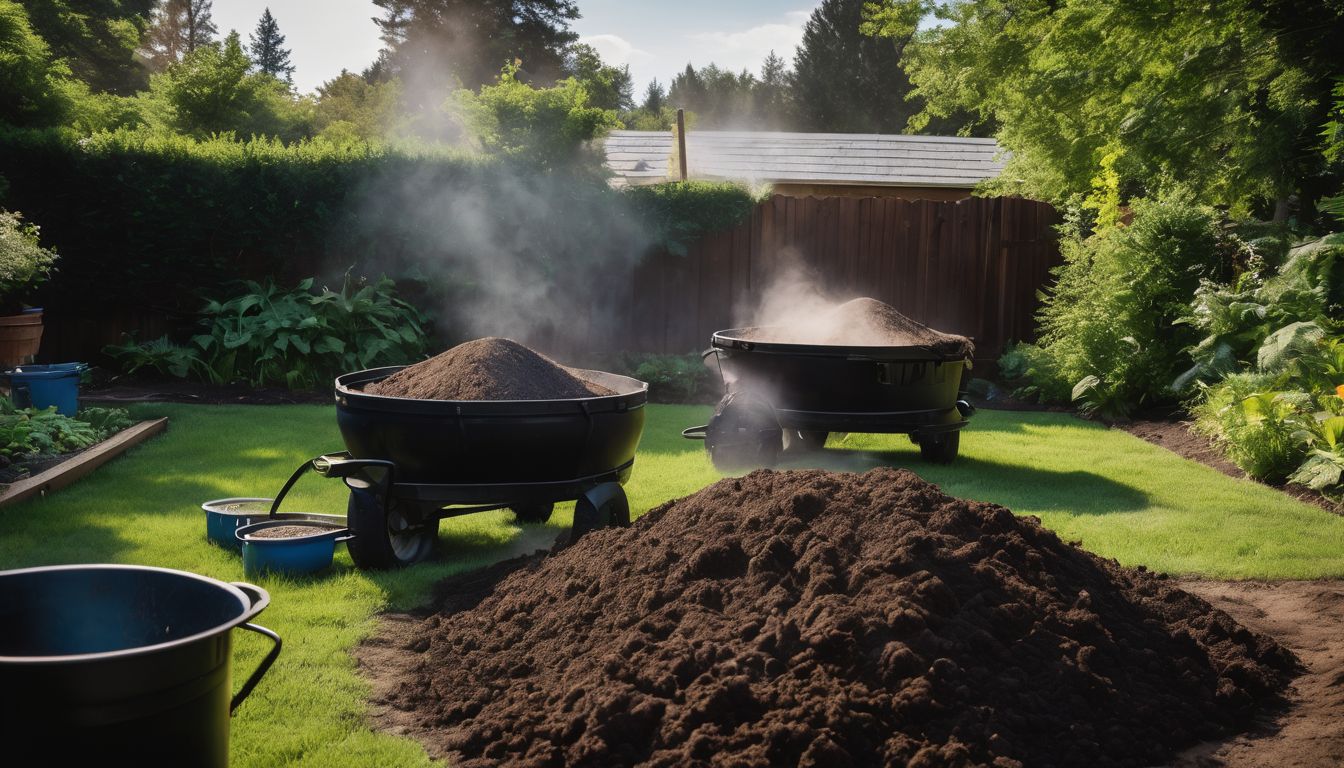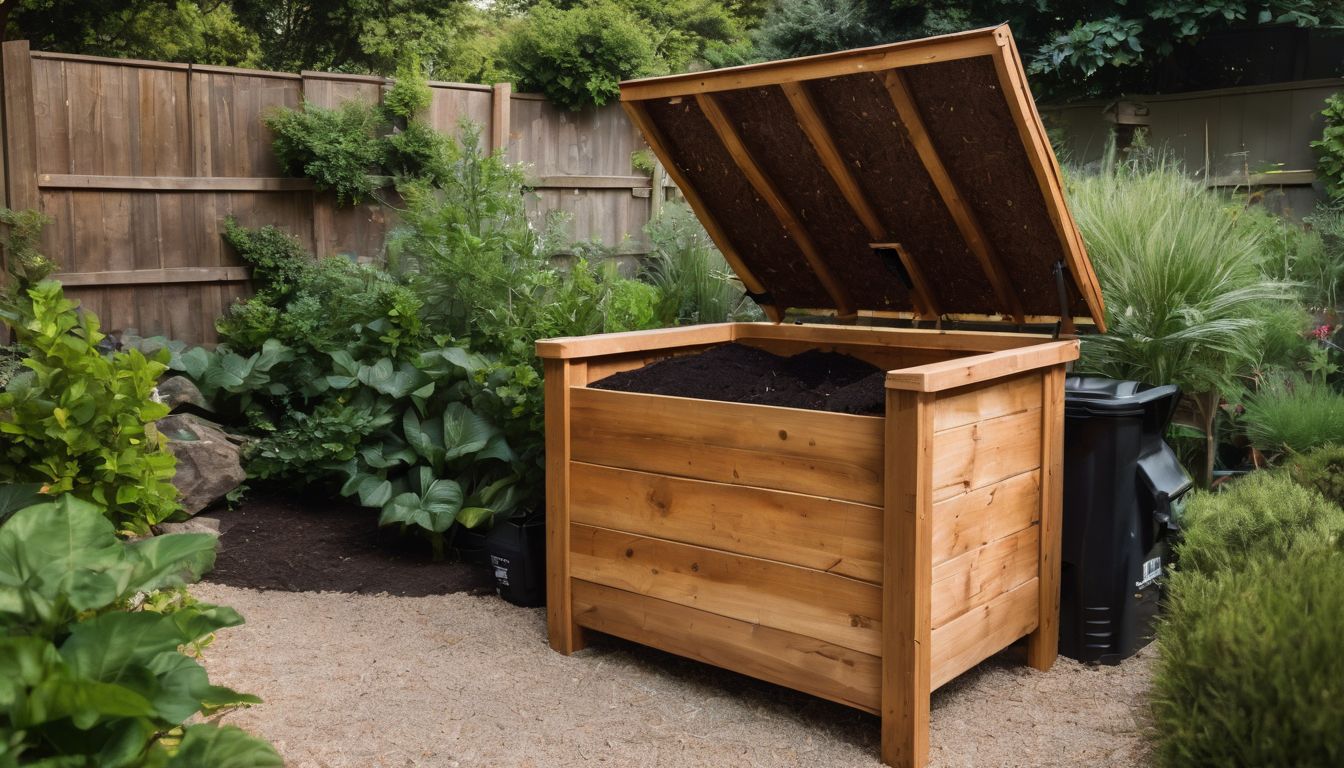Living in a bustling city often means grappling with the dilemma of waste disposal. Did you know that organic kitchen scraps make up about 50% of household waste? This post will unveil practical indoor composting strategies tailored for urban residents, transforming your food scraps into nutritious soil.
Discover how to turn waste woes into eco-wins!
Key Takeaways
- Urban composting cuts waste and emissions: City dwellers can significantly reduce their rubbish footprint by using indoor composting methods, such as worm bins or bokashi buckets. This also lessens methane production at landfills, combating climate change.
- Space-saving compost solutions exist: Apartment residents have various small-scale options like vermicomposting and in-place composting that work well within confined living spaces, turning kitchen scraps into valuable soil amendments.
- Controlling odours is manageable: By choosing the right bin equipped with carbon filters or keeping the correct balance of green and brown materials, you can avoid bad smells associated with decay even when composting indoors.
- Follow local guidelines for best results: Checking with city regulations ensures you engage in urban composting correctly—this helps maintain good relations with neighbours while contributing positively to community sustainability efforts.
- Compost enriches urban plants too: Just because space is at a premium doesn’t mean your plants can’t flourish. Adding finished compost to your potted plants or balcony garden improves soil health and boosts growth without needing a large outdoor area.
Benefits of Composting in Urban Areas
Composting in urban areas reduces waste and greenhouse gas emissions while providing valuable soil amendment for urban gardening. It is an environmentally friendly solution for managing organic waste in city settings.
Reduces waste
Indoor composting solutions empower urban dwellers to slash the amount of rubbish they send to landfills. By turning kitchen scraps and food waste into valuable compost, residents in small apartments contribute significantly to waste reduction efforts.
Urban composting systems transform what was once considered trash into a resource for urban gardens, closing the loop on organic waste management.
City composting isn’t just about being green; it’s a practical way to cut down on garbage bags and unpleasant odours from rotting food in bins. Implementing apartment composting techniques means fewer trips to the dumpster and more space saved in city landfills.
As more people embrace indoor worm composting or other methods suitable for compact spaces, collective action leads to less pressure on municipal disposal systems and promotes a culture of sustainability amidst urban congestion.
Reduces greenhouse gas emissions
Reducing greenhouse gas emissions is a significant benefit of composting in urban areas. By diverting organic waste from landfills, where it would generate methane, composting helps to mitigate the release of this potent greenhouse gas into the atmosphere.
Returning organic matter to the soil through composting also enhances carbon sequestration, further reducing the overall carbon footprint associated with waste disposal.
Composting methods such as vermiculture and in-situ composting facilitate the breakdown of organic materials without producing harmful emissions. These techniques help city dwellers play an active role in combating climate change by minimising their contribution to greenhouse gases.
Provides valuable soil amendment
Composting in urban areas yields a valuable soil amendment for gardens and indoor plants. The nutrient-rich compost enhances soil structure, improves water retention, and fosters healthy plant growth.
City dwellers can transform their food waste and organic materials into a beneficial resource for sustainable urban gardening practices.
To harness the benefits of compost as a valuable soil amendment, it’s essential to explore various indoor composting methods that suit urban living spaces. Keep reading to discover practical solutions for small-space composting techniques that enable environmentally conscious individuals to reduce waste while contributing positively to the environment.
Challenges of Composting in Urban Areas
Limited space in urban areas makes it difficult to find suitable composting spots, and concerns about odors can lead to resistance from neighbors or local regulations.
Limited space
With limited space in urban settings, traditional outdoor composting may not be feasible. However, there are several indoor composting solutions that can accommodate small living spaces.
Options such as vermicomposting with a worm bin or bokashi composting using airtight containers are efficient methods for those with limited room to spare. These techniques allow eco-conscious individuals living in flats or tight quarters to actively participate in organic waste management and contribute to environmental conservation efforts, even within the constraints of city living.
To address limited space constraints, urban dwellers can also consider utilising specialised compost bins designed for small spaces. These compact units are specifically tailored to fit into cramped flats or homes while still facilitating the decomposition of organic waste materials.
Odor concerns
Composting in limited space can lead to odour concerns, especially in urban environments where ventilation may be restricted. To address this issue, consider using airtight compost containers or specialised indoor compost bins designed to control odours and pests while still allowing for aerobic decomposition.
These bins utilise carbon filters and tight-sealing lids to manage odours effectively. Additionally, incorporating appropriate ratios of carbon-rich materials like shredded paper or dry leaves can help reduce odours by balancing the nitrogen content in the compost.
To further mitigate odour concerns, it’s essential to maintain proper moisture levels within the composting material and avoid overfilling the container. Regularly turning and aerating the compost will also promote airflow and prevent anaerobic conditions that contribute to foul smells.
Regulations
When dealing with urban composting, it’s crucial to understand the regulations in your area. Before starting any composting activities, be sure to check local ordinances and guidelines to ensure compliance.
Some municipalities have specific rules regarding the types of composting methods allowed, acceptable materials for composting, and odor control measures.
Adhering to these regulations not only helps you avoid potential fines but also contributes to a harmonious relationship with neighbors and community members. By following the established guidelines, you can engage in urban composting responsibly while contributing positively to your environment.
7 Methods of Urban Composting
Explore a variety of urban composting methods to find the best fit for your living situation and waste disposal needs. Read on to discover how you can easily implement these techniques in your city dwelling.
Open-air composting
Open-air composting is a simple and affordable method for urban dwellers to recycle organic waste. It involves creating a designated area in the garden or yard where organic materials like fruit peels, vegetable scraps, and yard waste can decompose naturally.
This process requires minimal effort and maintenance while allowing natural decomposition processes to break down the materials into nutrient-rich compost that benefits the soil.
Urban residents can make use of open-air composting to reduce their environmental footprint by diverting organic waste from landfills and creating valuable soil amendments for gardening.
Tumbler composting
Transitioning from open-air composting, tumbler composting offers a more contained and manageable approach to composting in small urban spaces. Tumbler composters are designed to efficiently break down organic materials by rotating the drum or barrel, providing adequate aeration and mixing.
This method effectively produces rich compost without taking up much space or causing odour issues. By utilising a tumbler composter, urban dwellers can conveniently manage their food waste while creating valuable soil amendment for houseplants or community gardens.
Tumbler composting simplifies the process of recycling kitchen scraps and garden trimmings into nutrient-rich compost in limited city living spaces. The controlled environment of the tumbler accelerates decomposition while minimising potential drawbacks often associated with traditional open-air methods.
Vermicomposting
Vermicomposting involves using earthworms to break down organic waste into nutrient-rich compost. This method is ideal for urban dwellers with limited space, as it can be done indoors in a small bin or container.
The worms digest the food scraps and other organic materials, converting them into high-quality compost that can be used to enrich soil for indoor plants or outdoor gardens. Urban vermicomposting is an effective way to reduce food waste and create sustainable resources for home gardening in city living.
Moving on to the next section, let’s explore “In-place Composting” methods suitable for urban spaces.
In-place composting
Transitioning from vermiculture to in-place composting, this method involves directly burying organic waste in garden beds or planters. By layering kitchen scraps and yard debris directly into the soil, nutrients are slowly released as the materials decompose.
To start in-place composting, simply dig a trench or hole in your garden bed, add your organic waste, and cover it with soil. Over time, the buried material will break down and enrich the soil while also reducing food waste.
In urban areas where space is limited, in-place composting offers an efficient way to recycle organic matter without needing additional space for traditional compost bins. This approach provides a continuous source of nutrients for plants while also helping to reduce overall environmental impact by diverting food scraps from landfills.
Bokashi composting
Bokashi composting is an effective method for urban dwellers with limited space. It uses beneficial microorganisms to ferment kitchen waste, including meat and dairy products, quickly turning them into nutrient-rich soil.
To start Bokashi composting, layer food waste in a special bucket with Bokashi bran, then press the mixture down firmly and seal the lid to create an anaerobic environment that accelerates the fermentation process.
After two weeks of fermentation, bury or mix the fermented material into soil to complete the decomposition process.
This method is particularly suitable for apartment dwellers because it doesn’t produce unpleasant odours when properly managed. The end product can be used as a soil amendment or liquid fertiliser, making it an excellent indoor composting solution for city living.
Municipal composting
Transitioning from Bokashi composting to municipal composting, urban dwellers can explore the option of utilising municipal composting facilities. Many cities offer kerbside collection programmes for organic waste, providing a convenient solution for residents with limited space.
By participating in municipal composting initiatives, individuals can contribute to reducing waste and greenhouse gas emissions on a larger scale while gaining access to high-quality compost for their urban gardens or community green spaces.
This communal effort supports sustainable living practices and encourages environmentally friendly behaviours within city environments.
In addition to kerbside collection programmes, some municipalities also operate centralised composting facilities where residents can drop off their organic waste. These centres efficiently manage large quantities of food scraps and yard trimmings, processing them into valuable soil amendments that benefit local agricultural and landscaping projects.
Tips for Successful Urban Composting
Balance carbon and nitrogen ratios to ensure proper decomposition, incorporate diverse materials for a well-rounded compost, monitor moisture levels regularly, turn and aerate compost to encourage airflow, and use composting additives to speed up the process.
Balance carbon and nitrogen ratios
To ensure successful indoor composting, it’s vital to balance the carbon and nitrogen ratios in your compost bin. Aim for a 30:1 carbon to nitrogen ratio by adding materials like dry leaves, straw, or paper (high in carbon) along with food scraps and green waste (high in nitrogen).
This optimal balance will support the decomposition process and prevent any foul odors from developing. By managing these ratios effectively, you can create nutrient-rich compost that is perfect for nourishing your indoor plants while reducing organic waste.
Incorporating diverse materials in your compost bin will help achieve the right balance of nutrients essential for producing high-quality compost. By adding a variety of kitchen scraps, yard waste, and other biodegradable materials into your composter, you can maintain an ideal environment for decomposition and beneficial microorganisms.
Incorporate diverse materials
To create healthy compost in limited space, use varied materials such as fruit and vegetable scraps, coffee grounds, eggshells, yard waste, and shredded newspaper. Rotate these materials in layers to maintain a balanced mix of nitrogen-rich greens and carbon-rich browns.
This diverse mix ensures efficient decomposition and produces high-quality compost for urban gardening needs.
Monitor moisture levels
To ensure successful urban composting, it is essential to monitor moisture levels. This helps maintain the right environment for microbial activity within the compost. Excessively dry conditions may slow down decomposition, while overly wet conditions could lead to odors and anaerobic decomposition.
Regularly check the moisture content of your compost pile or bin by squeezing a handful of material – it should feel like a damp sponge. Adjust as needed by adding water or bulking agents such as shredded paper or dry leaves to achieve optimal moisture levels for efficient composting.
Maintaining appropriate moisture levels in your compost is crucial for fostering a healthy environment that supports the natural breakdown of organic matter into nutrient-rich soil amendment.
Turn and aerate compost
To ensure proper decomposition, turn and aerate your compost regularly. Use a pitchfork or shovel to mix the materials, bringing the outer layers to the center and vice versa. This process introduces oxygen to all parts of the heap, encouraging microbial activity and preventing odors from developing.
Aim for turning every one to two weeks, adjusting based on compost moisture levels – keyword “small space composting solutions“.
Composting additives can help speed up decomposition and improve overall quality. Incorporate items such as garden soil, finished compost, or commercial accelerators into the pile when turning it – keyword “indoor food waste composting”.
Use composting additives
To ensure optimal composting, consider using additives to enhance the decomposition process. Composting additives such as lime or wood ash can help balance the pH levels in your compost, creating a more hospitable environment for microorganisms to thrive.
In addition, adding organic materials like manure or comfrey leaves introduces beneficial bacteria and accelerates decomposition, resulting in nutrient-rich compost for your urban garden.
By incorporating these additives into your composting routine, you can maintain a healthy and efficient system even within limited urban spaces.
Harvesting and Using Home Compost
Once your compost is mature, it will be dark and crumbly with an earthy smell. You can use it to enrich the soil in your urban garden, balcony planters, or even indoor potted plants.
Signs of mature compost
Mature compost has a dark, crumbly texture and an earthy smell. It should look like rich, dark soil and be free of recognisable food scraps or yard waste. When mature, the compost temperature will stabilise to match the surrounding environment, indicating that decomposition has slowed down.
Additionally, mature compost is teeming with earthworms and other beneficial microorganisms that help plants thrive.
Once mature compost looks, smells, and feels like healthy soil without any lingering odours of rotting materials or excessive moisture. The final product will be ready for use in gardens as a nutrient-rich amendment for plants.
How to use compost in urban settings
Use mature compost as a soil amendment in urban gardens, pots, or window boxes. Spread a 2-3 inch layer of compost over the soil and gently mix it in to boost plant growth and improve soil structure.
Add compost to indoor houseplants’ potting mix for added nutrients and improved water retention without fear of odor or mess. This enriches the soil, resulting in healthier plants that require less watering.
For city dwellers maintaining indoor plants tight on space, compacting their useable area – making a valuable resource such as compost essential in promoting healthy plant growth.
Conclusion
In conclusion, indoor composting offers practical solutions for urban dwellers. Various techniques such as vermicomposting and bokashi composting cater to limited space and odour concerns.
By implementing these small-scale composting methods, city residents can reduce waste, minimise greenhouse gas emissions, and create valuable soil amendments right at home. With the right tools and practices, urban composting is accessible to all who seek to make a positive impact on their environment.
FAQs
1. What are indoor composting solutions for urban dwellers?
Indoor composting solutions allow city living folks to turn their food waste into compost through methods like worm bin composting and kitchen composting, right in their own small flats.
2. Can you really compost if you live in a tiny flat?
Absolutely! With small space composting solutions such as compact bins designed for flat composting, anyone can manage organic waste even with limited space.
3. Are there special tips for doing city composting effectively?
Certainly! Indoor food waste composting techniques adapted for city dwellers include controlling moisture levels and choosing the right mix of greens and browns to aid decomposition without odours.
4. Is it practical to use a worm bin for indoor organic waste management?
Yes, using a worm bin is an excellent option because these creatures work wonders by breaking down your scraps into high-quality fertiliser – perfect for small space confines!
5. Where can someone find more information about an apartment-composting guide?
There are plenty of resources available that provide detailed steps on safe and efficient ways to carry out the process of composting within your home or flat’s unique constraints.





